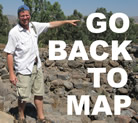| |
|
This is a view of the east side of the City of David with the Kidron Valley beginning to drop down in the far left of the picture.
The stones in the middle are the remains of a Jebusite wall of the ancient city from around 1200-1400 BC. |
|
| The Jebusite wall stood over five stories tall. Enemies would have had to approach this wall coming up out of the step and rugged Kidron Valley. This city was protected by the Kidron Valley on the east and the Central Valley on the west. The Hinnom Valley cut across the south end. The Jebusite wall like this one made the city even more impossible to enter. |
|
| The remains of the Jebusite wall. |
|
| There would have been homes built into the terraces on the outside of the wall. These residences can be seen here. |
|
| The rock with a hole and the carved indention around the hole is apparently an ancient toilet seat. |
|
Recent escavation believes the palace of David has been located on the northern end of the City of David.
This northern end would have always been the location of the cities greatest fortress since it is the only place not defended by a natural rugged valley. |
|
| The City of David Viewed from the south. The city is the area directly to the south of the temple mound. The full picture shows the city of Jerusalem 1,000 after David. The Kidron Valley is on the right. The Central Valley runs up the left side of David's city (this valley has been filled in and built over in this model. The Hinnom Valley (out this picture to the bottom and left) cuts in on the bottom from the left to join the Kidron Valley on the cities south side. |
|
| |
|
| |
|


